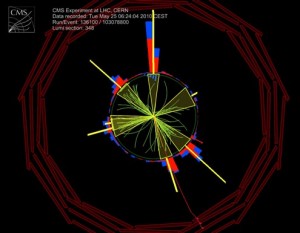Cosmic questions
Answers to two of the most stubborn questions in science may come down to one point – the point where one particle smashes into another.
The first question comes from physics: What is the strong force? Particles called gluons exert this force inside subatomic particles, keeping protons and neutrons from flying apart in a shower of quarks.
Cosmology gives rise to the second question: What happened in the first microseconds after the Big Bang? A portion of the energy released in that cosmos-spawning event was transformed into the matter that makes up the known universe. But how did that matter form?
Last fall, Dragos Velicanu revealed clues to these mysteries. His presentation won the Klaus Kinder-Geiger Award for best talk at the Hot Quarks meeting, a biennial workshop for young scientists who study the physics of ultrarelativistic (near light speed) collisions between atomic nuclei.
Velicanu, a Department of Energy Computational Science Graduate Fellowship recipient and doctoral candidate in high-energy physics at the Massachusetts Institute of Technology, reported findings from a series of collisions that lasted 4 hours, 20 minutes in September 2012. The experiment was conducted by the CMS Collaboration, an international group of more than 3,000 scientists, engineers and students using the Compact Muon Solenoid detector at the Large Hadron Collider (LHC), the giant particle collider at CERN, the European physics laboratory. By pitting protons against lead nuclei, the collaboration found a new wrinkle in an unexplained correlation between charged particles that spew out of such collisions.
To analyze the results, Velicanu worked with Wei Li, a former MIT postdoctoral fellow who now is an assistant professor at Rice University. “Together Wei Li and I did the whole analysis completely independently to cross-check our results and help us find and fix bugs,” Velicanu says. “I also helped design, test and monitor some of the triggers used in this and upcoming analyses. Triggers are the algorithms and hardware/software we use to collect our data.”
Cosmologists and physicists agree that answers to their two fundamental questions must lie in quark-gluon plasma, or QGP, a species of matter a particle collider can create. QGP also existed during the universe’s first microseconds. In a QGP, quarks are freed from their partners but, still in the grip of the strong force, move around within a fireball no bigger than the original particles. The QGP winks out of existence in billionths of a second as the quarks recombine, forming everyday protons and neutrons.
However, as these pedestrian particles form, other particles escape from the fireball. By detecting these, scientists intend to find answers to both questions.
The CMS lies 100 meters underground and measures 21 meters long and 15 meters in diameter. With its array of instruments, it can detect not just the muons that inspired its name but also many other particle types. When CMS researchers sent protons into head-on collisions with lead nuclei, the instrument fielded particles from about 2 million collisions, detecting countless charged particles – mostly pions, the lightest union of quark and antiquark.
Velicanu and Li selected only collisions that shot at least 110 charged particles out to the sides – a sign of a direct hit between proton and nucleus – giving them a comparatively small sample to analyze. They calculated the angle between every conceivable pair of charged particles. Then they searched for correlations among the angles.
“We primarily use distributed computing systems,” Velicanu says. “To run thousands of jobs in parallel, I use either Condor at the MIT cluster, which can run a given program with unique parameters on thousands of computers simultaneously, or CRAB, which I can submit to the entire LHC computing grid that’s spread out around the world, and simultaneously run a program on data held in different continents.”





